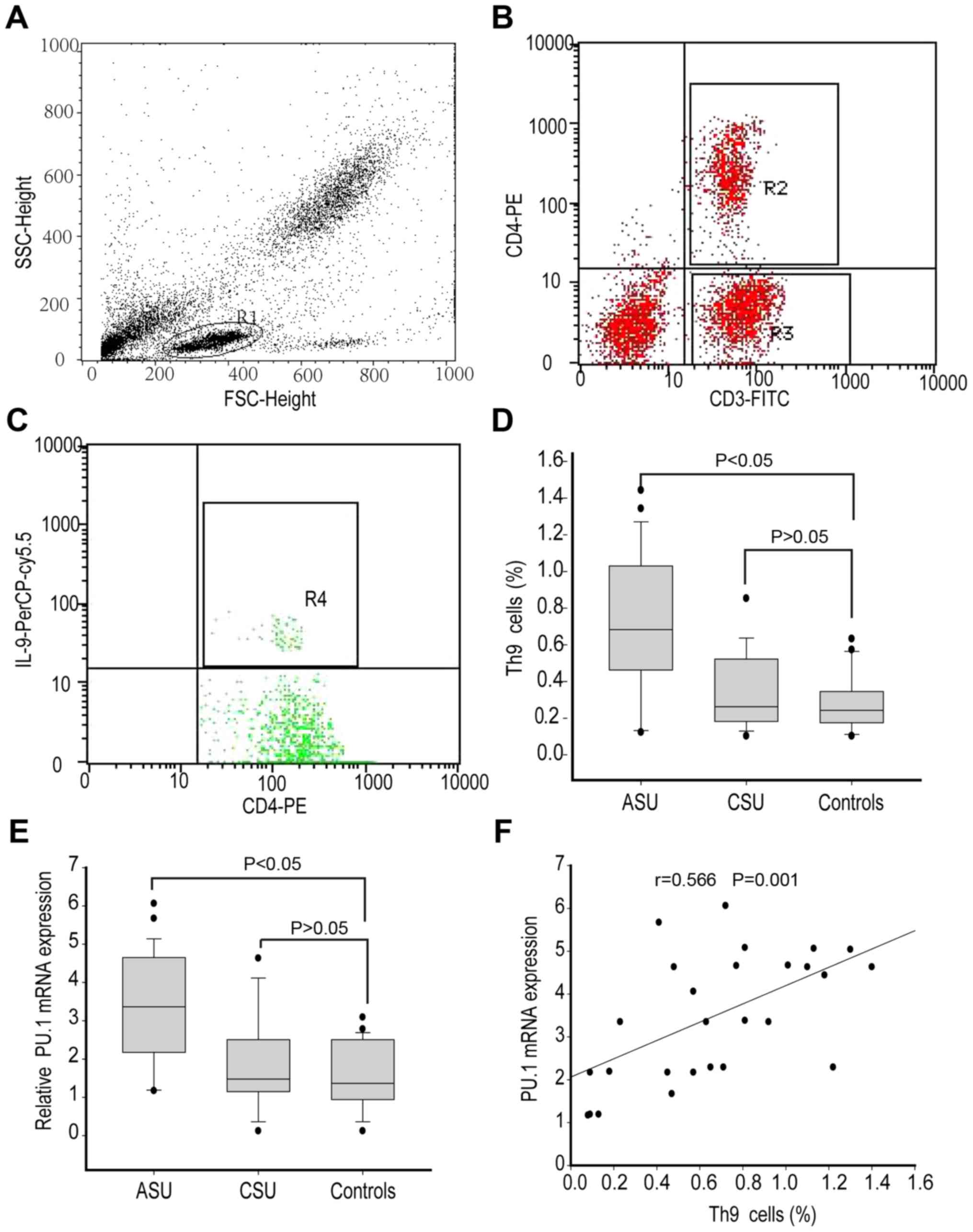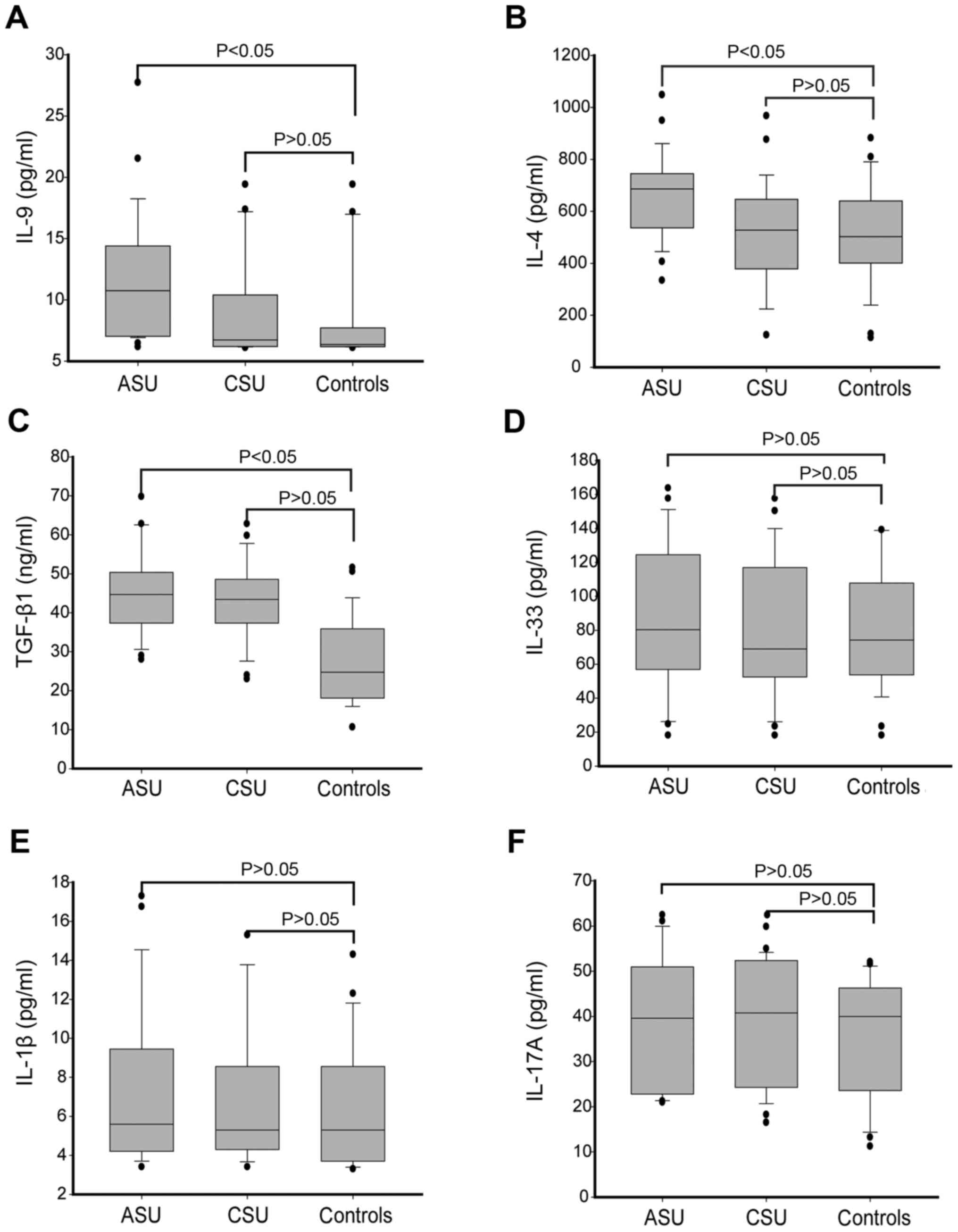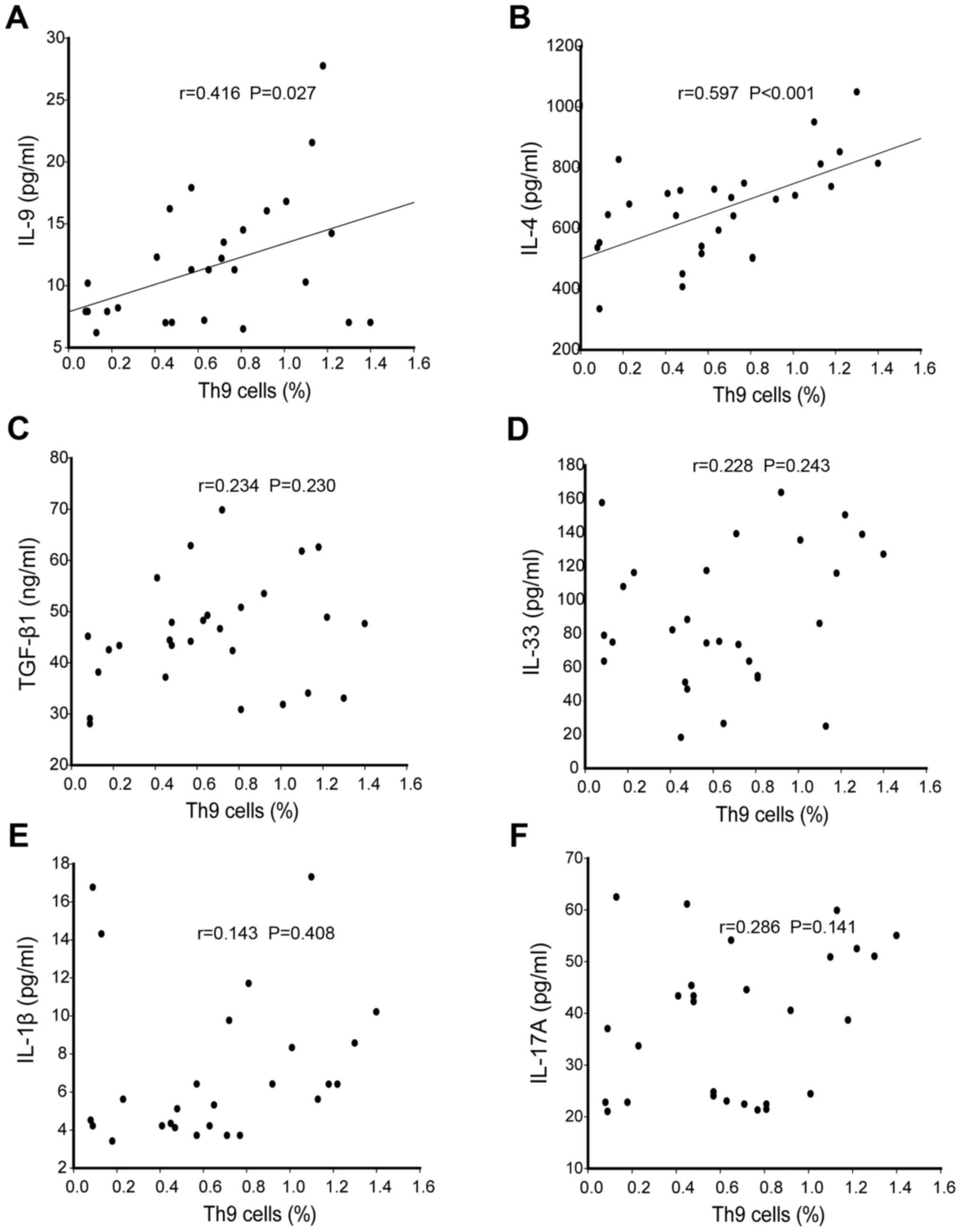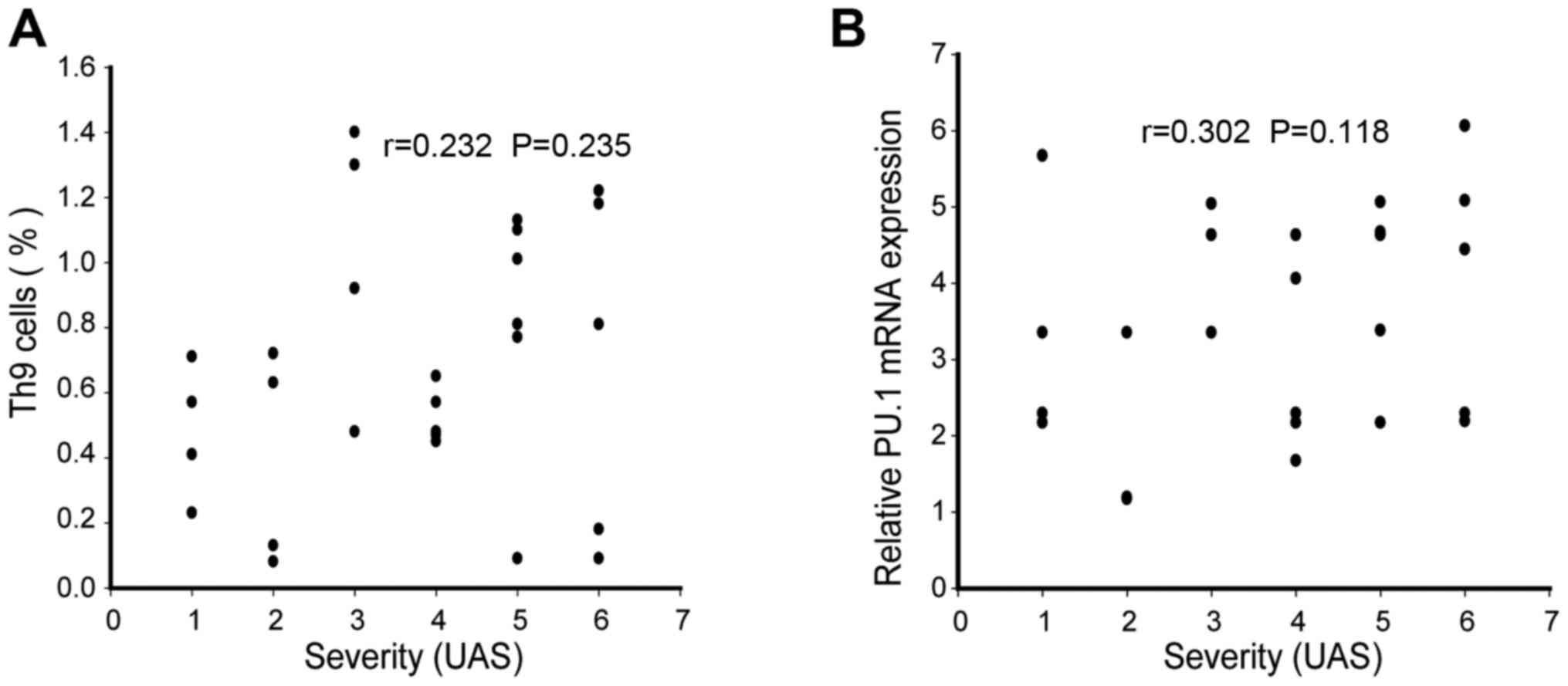Analysis of the changes in Th9 cells and related cytokines in the peripheral blood of spontaneous urticaria patients
- Authors:
- Published online on: May 3, 2017 https://doi.org/10.3892/br.2017.904
- Pages: 633-639
-
Copyright: © Zheng et al. This is an open access article distributed under the terms of Creative Commons Attribution License.
Abstract
Introduction
Spontaneous urticaria (SU) is a common skin condition characterized by the recurrent appearance of pruritic wheals, occasionally accompanied by angioedema (1). Analysis of skin biopsies from SU patients has demonstrated that most inflammatory cells surrounding the small venules include CD4+ T cells, neutrophils, mast cells, basophils and eosinophils (2,3). In particular, the release of histamine and other proinflammatory mediators, due to aberrant activation of mast cells, is the key pathophysiological event for urticaria (4). However, the mechanistic insight into mast cells degranulation remains poorly understood (5).
Recent studies have indicated that Th9 cells, a subset of T-helper cells, serve a key role in mast cell accumulation and activation during allergic inflammation (6,7), and are a major source of interleukin-9 (IL-9). PU.1 (also known as SPI1) is the key transcription factor through which Th9 cells regulate IL-9 production. More importantly, the study by Schlapbach et al (8) revealed that most memory Th9 cells were skin-tropic and appeared to possess both autocrine and paracrine pro-inflammatory abilities (8). Moreover, gene expression analysis of SU skin lesions had also demonstrated significant upregulation of cytokine IL-9 signaling pathways (9). These data overall indicate that Th9 cells serve an important role in skin inflammatory diseases.
Cytokines have generally been known to be critical to skin inflammation and regulation of naive T cell differentiation into distinct effector T cells subsets. For example, IL-4 stimulation leads to Th2 cell polarization, while TGF-β induce regulatory T cell differentiation (10). However, it has been observed that, in the absence of IL-6, TGF-β and IL-4 induce Th9 cell generation (11). Additionally, IL-1β and IL-33 stimulation can induce Th9 cell differentiation by the activation of nuclear factor-κB (12,13). Despite considerable attention paid to the research of Th9 cells and related cytokines, their expression levels and roles in SU patients remain largely unclear.
Thus, in the present study, the authors have made an effort to understand the contribution of Th9 cells in the pathogenesis of SU, by comparing Th9 cell populations in the peripheral blood of patients with SU and healthy controls, along with analyzing the expression of the transcription factor PU.1. Moreover, as cytokines have been linked with the regulation of Th9 cell differentiation and function, the authors assessed the plasma concentrations of cytokines, IL-4, IL-9, IL-17A, IL-33, IL-1β and transforming growth factor-β1 (TGF-β1). Finally, the correlation between Th9 cells population and levels of cytokines was explored.
Materials and methods
Study design
The present study is a case-control study (EC/2015/005) approved by the Ethics Committee of Binhai County Hospital (Yancheng, China). The study was conducted in the Dermatology Clinic at Binhai County Hospital (Yancheng, China) between November 2015 and March 2016, following obtaining written informed consent from all patients.
Study participants
The current study comprised 28 healthy volunteers and 56 patients diagnosed with acute SU (ASU, hives lasting <6 weeks; n=28) or chronic SU (CSU, hives lasting >6 weeks; n=28), who were all 12 years or older. SU patients were interviewed regarding the duration and type of urticaria by trained dermatologists, and the average urticaria activity score was measured to assess disease severity (typically, 7 days) based on EAACI/GA(2)LEN/EDF/WAO guidelines (14). Treatment was suspended for at least 2 weeks prior to enrolling patients in the study. Patients with physical, cholinergic, aquagenic, contact and exercise-induced urticaria were excluded from the study.
Healthy volunteers (n=28) who were blood donors in the control group were age and sex matched. Any patients receiving immunosuppressive medication or with any immune system disorder were excluded. Clinical characteristics of the subjects are summarized in Table I.
Blood sample preparation
At the initial visit, 8 ml peripheral blood was drawn from each subject in a tube with heparin sodium. Out of the 8 ml blood, 1 ml was used for flow cytometric detection of the Th9 cell population within 24 h according to manufacturer's instructions. Another 2 ml was used for preparation of serum and the remaining 5 ml was used for the isolation of peripheral blood mononuclear cells (PBMCs). All blood samples were obtained before patients received any treatment.
Detection of Th9 cell population in peripheral blood
For Th9 cell detection, peripheral blood cells (100 µl) were activated with phorbol-12-myristate-13-acetate (50 ng/ml) and ionomycin (1 µg/ml) in the presence of 1 µg/ml brefeldin (all from Sigma-Aldrich; Merck KGaA, Darmstadt, Germany) for 5 h at 37°C. Following activation, the samples were stained with fluorescein isothiocyanate-labeled anti-CD3 (cat. no. 555339), and phycoerythrin-labeled anti-CD4 (cat. no. 555347) monoclonal antibodies for 30 min (BD Biosciences, San Jose, CA, USA) at room temperature according to the manufacturer's instructions. This was followed by the lysis of red blood cells (BD Biosciences) and fixation with BD Cytofix™ fixing buffer (BD Biosciences). Next, cells were permeabilized by adding BD Perm/Wash™ buffer (BD Biosciences) and incubated with PerCP-cy5.5 labeled anti-IL-9 (cat. no. 561461; 1:10; BD Biosciences) and PEcy7 labeled anti-IL-17 antibodies (cat. no. 25717942; 1:10; eBioscience, Inc.; Thermo Fisher Scientific, Inc., Waltham, MA, USA) for 30 min at room temperature. Finally, the labeled cells were suspended in 200 µl phosphate-buffered saline and immediately analyzed with CellQuest Pro (BD Biosciences). CD4+ T cells with the CD4+IL-9+IL-4−IL-17− phenotype represented the Th9 cell population.
RNA isolation and reverse transcription-quantitative polymerase chain reaction (RT-qPCR)
PBMCs purified by Ficoll-Hypaque density gradient centrifugation method (Shanghai Westang Bio-Tech Co., Ltd., Shanghai, China) were used to isolate total RNA using TRIzol reagent (Invitrogen; Thermo Fisher Scientific, Inc.). cDNA synthesis and amplification was done using isolated RNA with the cDNA Reverse Transcription kit (Applied Biosystems; Thermo Fisher Scientific, Inc.) and QuantiTect SYBR Green PCR kit (Invitrogen; Thermo Fisher Scientific, Inc.), respectively. The following primer sequences were used for gene specific amplification: PU.1 sense, 5′-TGAGAAGGACAGGGAGCCAA-3′ and antisense, 5′-GAGAAGCTGAGTGCCATGCA-3′; β-actin sense, 5′-TGGCACCCAGCACAATGAA-3′ and antisense, 5′-CTAAGTCATAGTCCGCCTAGAAGCA-3′. The reaction mix was run with each 20 µl reaction containing ~50 ng cDNA, 0.3 µM sense and antisense primers on a thermal cycler [7500 PCR system (Applied Biosystems; Thermo Fisher Scientific, Inc.)] with following conditions: 1 min at 95°C, followed by 40 cycles at 95°C for 15 sec and 60°C for 1 min. The relative mRNA levels of the PU.1 gene were calculated by the 2−ΔΔCq method (15).
Cytokine analysis
To detect cytokines, serum samples were collected from 2 ml peripheral blood and immediately stored at −80°C, until cytokine analysis. The detection of cytokines IL-4, IL-17A, IL-9, TGF-β1, IL-1β and IL-33 was performed according to the manufacturer's protocol (Bio-Rad Laboratories, Inc., Hercules, CA, USA), and their concentrations were determined using Luminex 200 (Luminex Corporation, Austin, TX, USA). Each sample was measured twice and the mean value was used for statistical analysis. The minimum detectable concentrations of cytokines IL-9, IL4, IL-17A, TGF-β1, IL-1β and IL-33 in the present assay were 6.17, 13.10, 9.21, 6.12, 3.12 and 2.16 pg/ml, respectively.
Statistical analysis
Statistical analysis was performed using Stata (version, 7.0; (StataCorp LLC, College Station, TX, USA) software. The skewed data were expressed as median (M, 25–75 percentiles). Statistical significance between three and two groups was determined by the Kruskai-Wallis test and a two-tailed Mann-Whitney U test, respectively. The normal distribution of data was presented as mean ± standard deviation and statistical significance in two groups was compared using the Student's t-test. Linear correlations were calculated by Spearman coefficients. P<0.05 was considered to indicate a statistically significant difference.
Results
ASU patients displayed increased Th9 cell population
Changes in Th9 cell population have been reported in patients with allergic skin diseases (16). Here, the authors assessed the percentage of Th9 cells (Fig. 1A-C) in peripheral blood isolated from ASU, CSU and healthy control subjects. The data demonstrated that ASU patients had a higher percentage of Th9 cells (median 0.65%, range 0.43–0.97%; P<0.05) when compared to CSU patients (median 0.21%, range 0.13–0.44%) and healthy controls (median 0.20%, range 0.13–0.32%) as indicated in Fig. 1D. However, the percentage of Th9 cells indicated similarities between CSU patients and healthy controls (P>0.05; Fig. 1D).
Next, the authors assessed the mRNA levels of PU.1, which is the primary transcription factor involved in Th9-mediated function. RT-qPCR analysis suggested that the expression of PU.1 mRNA was significantly increased in the PBMCs isolated from ASU patients (median 3.44, range 2.23–4.85; P<0.05) in comparison to CSU patients (median 1.41, range 1.13–2.52) and healthy controls (median 1.32, range 0.98–2.36), as presented in Fig. 1E. However, CSU patients and healthy controls did not present any significant difference. Moreover, the percentage of Th9 cells also demonstrated a positive correlation with PU.1 mRNA levels (r=0.566, P<0.05) in ASU patients (Fig. 1F).
Comparison of Th9 related cytokines in SU patients
As cytokines can affect Th9 cells differentiation and function, serum concentrations of cytokines IL-9, IL-33, IL-4, TGF-β1, IL-1β and IL-17A were measured. It was observed that ASU patients had higher levels of IL-9 and IL-4 (P<0.05) compared to CSU patients and healthy controls, although there was no significant difference between them (P>0.05), as identified in Fig. 2A and B. However, TGF-β1 presented higher levels in both ASU and CSU patients as compared to healthy controls (P<0.05; Fig. 2C), whereas no significant differences were observed in IL-33, IL-1β and IL-17A levels between these three groups (P>0.05; Fig. 2D-F).
Th9 cell percentage and serum cytokines IL-4 and IL-9 levels demonstrated a positive correlation in ASU patients
Next, the authors examined whether there was any correlation between the percentage of Th9 cells and the concentrations of cytokines TGF-β1, IL-4 IL-9, IL-1β, IL-33 and IL-17A in the serum of ASU patients. Interestingly, a positive correlation was observed between the percentage of Th9 cells and the concentration of IL-9 (r=0.644, P<0.05) and IL-4 (r=0.444, P<0.05) in serum, as presented in Fig. 3A and B. However, Th9 cell percentage did not demonstrate any correlation with the concentrations of TGF-β1, IL-1β, IL-17A and IL-33 cytokines in the serum of ASU patients (P>0.05; Fig. 3C-F).
Th9 cell percentage and PU.1 mRNA expression did not present correlation with disease severity in ASU patients
Finally, the correlation between urticaria activity score and the levels of Th9 cells and PU.1 mRNA expression was tested in ASU patients. The current analysis revealed that disease severity indicated no correlation with the percentage of Th9 cells (r=0.232, P>0.05,) and PU.1 mRNA expression (r=0.302, P>0.05) in the peripheral blood (Fig. 4A and B).
Discussion
The present study identified that ASU patients displayed significantly increased frequency of Th9 cells in peripheral blood than CSU patients and healthy controls. This observation was consistent with RT-qPCR results, which demonstrated higher mRNA expression of the PU.1 transcription factor, primarily responsible for Th9 cell-mediated regulation of IL-9 production. In addition, there were increased levels of Th9-related cytokines, such as TGF-β1, IL-9 and IL-4 in the peripheral blood of ASU patients, which has been suggested to serve an important role in Th9 development (11).
PU.1 is a transcription factor implicated in the regulation of Th9 cells function by directly binding to IL-9 loci (17). The observation of an increased percentage of Th9 cells along with higher expression of PU.1 mRNA and IL-9 cytokine in the peripheral blood of ASU patients suggested that, Th9 is functionally important in ASU. The study by Ma et al (16) also confirmed the pathogenic role of Th9 cells in atopic dermatitis based on similar findings. Furthermore, Th9 cell percentage positively correlated with IL-9 levels. As it has been suggested previously that Th9 cells appear to be important cellular sources of IL-9, which contributes to mast cell proliferation (6), it seems logical that Th9 cells may serve an important role in SU, which involves mast cell regulation. However, surprisingly, a correlation between an increased proportion of Th9 cells and disease severity in ASU patients was not observed. The tentative explanation may be that Th9 cells were skin-tropic or skin-resident, as described previously (8).
In addition, the association between the plasma TGF-β1 levels and the risk of SU has been reported in a previous study (18). Patients with CSU displayed TGF-β genetic variability, which leads to increased production of TGF-β (19,20). In agreement with these findings, the present data indicated that ASU patients had significantly high plasma levels of TGF-β1 and IL-4, which may account for increased Th9 development (11).
IL-33, the other epithelial cytokine, and a newly recognized member of the IL-1 family, is a multifunctional protein. It has been reported to bind to the cell membrane receptor ST2 and promote Th2 responses in T cells, mast cells, eosinophils, basophils and innate lymphoid cell populations (21). Consistent with a previous report (22), the present study confirmed that all three groups had similar levels of IL-33, and thus indicated that a Th2 response may not be important in SU pathogenesis. However, IL-1β has been presented to induce Th9 differentiation (13), but similar levels between SU patients and controls were also observed.
Another cytokine, IL-9, following stimulation by Jak1, can also induce Th17 cell proliferation (23). Th17 cytokines, such as IL-17A-F, are believed to be crucially involved in the pathogenesis of some autoimmune diseases (24). However, there are some discrepancies between the results of the levels of IL-17 in ASU and CSU patients reported in different studies (19,25,26). These data, however, demonstrated no significant difference in IL-17A levels between ASU, CSU patients and healthy controls.
Importantly, the current study has a few limitations. Firstly, due to the limitation of the study protocol, it could not be determined whether the increase in Th9 cell population was primary or secondary to other changes, such as TGF-β1 and IL-4 in the peripheral blood. Secondly, the sample size of patients with SU and healthy controls was very small. Thirdly, it has been shown that ~30–50% of patients with CSU produce circulating antibodies, while most cases of ASU are associated with viral infections or allergens (5,27). Thus, in future studies, the authors intend to investigate the effect of Th9 cells underlying each of these precipitating factors.
In conclusion, the present study demonstrated that the percentage of Th9 cells in the peripheral blood of ASU patients was markedly increased when compared to healthy controls. Furthermore, ASU patients exhibited an increased Th9 related cytokines, such as TGF-β1 and IL-4. These results indicated that the increased levels of Th9 cells may serve a role in the pathogenesis of SU.
Acknowledgements
The present study was supported by a grant from Medical and Health Technology Development Program in Yancheng City, China (grant no. YK2015065).
Glossary
Abbreviations
Abbreviations:
|
SU |
spontaneous urticaria |
|
PBMCs |
peripheral blood mononuclear cells |
|
TGF-β |
transforming growth factor-β |
|
IL |
interleukin |
|
PBS |
phosphate-buffered saline |
|
Th |
T helper cells |
|
UAS |
urticarial activity score |
References
|
Godse K, Rajagopalan M, Girdhar M, Kandhari S, Shah B, Chhajed PN, Tahiliani S, Shankar DS, Somani V and Zawar V: Position statement for the use of omalizumab in the management of chronic spontaneous urticaria in Indian patients. Indian Dermatol Online J. 7:6–11. 2016. View Article : Google Scholar : PubMed/NCBI | |
|
Caproni M, Volpi W, Macchia D, Giomi B, Manfredi M, Campi P, Cardinali C, D'Agata A and Fabbri P: Infiltrating cells and related cytokines in lesional skin of patients with chronic idiopathic urticaria and positive autologous serum skin test. Exp Dermatol. 12:621–628. 2003. View Article : Google Scholar : PubMed/NCBI | |
|
Kay AB, Ying S, Ardelean E, Mlynek A, Kita H, Clark P and Maurer M: Elevations in vascular markers and eosinophils in chronic spontaneous urticarial weals with low-level persistence in uninvolved skin. Br J Dermatol. 171:505–511. 2014. View Article : Google Scholar : PubMed/NCBI | |
|
Jafilan L and James C: Urticaria and Allergy-Mediated Conditions. Prim Care. 42:473–483. 2015. View Article : Google Scholar : PubMed/NCBI | |
|
Fine LM and Bernstein JA: Urticaria Guidelines: Consensus and Controversies in the European and American Guidelines. Curr Allergy Asthma Rep. 15:302015. View Article : Google Scholar : PubMed/NCBI | |
|
Sehra S, Yao W, Nguyen ET, Glosson-Byers NL, Akhtar N, Zhou B and Kaplan MH: TH9 cells are required for tissue mast cell accumulation during allergic inflammation. J Allergy Clin Immunol. 136:433–40.e1. 2015. View Article : Google Scholar : PubMed/NCBI | |
|
Licona-Limón P, Henao-Mejia J, Temann AU, Gagliani N, Licona-Limón I, Ishigame H, Hao L, Herbert DR and Flavell RA: Th9 cells drive host immunity against gastrointestinal worm infection. Immunity. 39:744–757. 2013. View Article : Google Scholar : PubMed/NCBI | |
|
Schlapbach C, Gehad A, Yang C, Watanabe R, Guenova E, Teague JE, Campbell L, Yawalkar N, Kupper TS and Clark RA: Human TH9 cells are skin-tropic and have autocrine and paracrine proinflammatory capacity. Sci Transl Med. 6:219ra82014. View Article : Google Scholar : PubMed/NCBI | |
|
Patel OP, Giorno RC, Dibbern DA, Andrews KY, Durairaj S and Dreskin SC: Gene expression profiles in chronic idiopathic (spontaneous) urticaria. Allergy Rhinol (Providence). 6:101–110. 2015. View Article : Google Scholar : PubMed/NCBI | |
|
Caza T and Landas S: Functional and Phenotypic Plasticity of CD4(+) T Cell Subsets. BioMed Res Int. 2015:5219572015. View Article : Google Scholar : PubMed/NCBI | |
|
Veldhoen M, Uyttenhove C, van Snick J, Helmby H, Westendorf A, Buer J, Martin B, Wilhelm C and Stockinger B: Transforming growth factor-beta ‘reprograms’ the differentiation of T helper 2 cells and promotes an interleukin 9-producing subset. Nat Immunol. 9:1341–1346. 2008. View Article : Google Scholar : PubMed/NCBI | |
|
Blom L, Poulsen BC, Jensen BM, Hansen A and Poulsen LK: IL-33 induces IL-9 production in human CD4+ T cells and basophils. PLoS One. 6:e216952011. View Article : Google Scholar : PubMed/NCBI | |
|
Anuradha R, George PJ, Hanna LE, Chandrasekaran V, Kumaran P, Nutman TB and Babu S: IL-4-, TGF-β-, and IL-1-dependent expansion of parasite antigen-specific Th9 cells is associated with clinical pathology in human lymphatic filariasis. J Immunol. 191:2466–2473. 2013. View Article : Google Scholar : PubMed/NCBI | |
|
Zuberbier T, Asero R, Bindslev-Jensen C, Canonica G Walter, Church MK, Giménez-Arnau A, Grattan CE, Kapp A, Merk HF, Rogala B, et al: EAACI/GA(2)LEN/EDF/WAO guideline: definition, classification and diagnosis of urticaria. Allergy. 64:1417–26. 2009. View Article : Google Scholar : PubMed/NCBI | |
|
Livak KJ and Schmittgen TD: Analysis of relative gene expression data using real-time quantitative PCR and the 2(−Delta Delta C(T)) Method. Methods. 25:402–408. 2001. View Article : Google Scholar : PubMed/NCBI | |
|
Ma L, Xue HB, Guan XH, Shu CM, Zhang JH and Yu J: Possible pathogenic role of T helper type 9 cells and interleukin (IL)-9 in atopic dermatitis. Clin Exp Immunol. 175:25–31. 2014. View Article : Google Scholar : PubMed/NCBI | |
|
Goswami R and Kaplan MH: Gcn5 is required for PU.1-dependent IL-9 induction in Th9 cells. J Immunol. 189:3026–3033. 2012. View Article : Google Scholar : PubMed/NCBI | |
|
Tavakol M, Movahedi M, Amirzargar AA, Aryan Z, Bidoki AZ, Heidari K, Soltani S, Gharagozlou M, Aghamohammadi A, Nabavi M, et al: Association of interleukin 10 and transforming growth factor β gene polymorphisms with chronic idiopathic urticaria. Acta Dermatovenerol Croat. 22:239–245. 2014.PubMed/NCBI | |
|
Daschner A, Rodero M, de Frutos C, Valls A, Vega F, Blanco C and Cuéllar C: Different serum cytokine levels in chronic vs. acute Anisakis simplex sensitization-associated urticaria. Parasite Immunol. 33:357–362. 2011. View Article : Google Scholar : PubMed/NCBI | |
|
Papadopoulos J, Karpouzis A, Tentes J and Kouskoukis C: Assessment of Interleukins IL-4, IL-6, IL-8, IL-10 in Acute Urticaria. J Clin Med Res. 6:133–137. 2014.PubMed/NCBI | |
|
Matta BM, Lott JM, Mathews LR, Liu Q, Rosborough BR, Blazar BR and Turnquist HR: IL-33 is an unconventional Alarmin that stimulates IL-2 secretion by dendritic cells to selectively expand IL-33R/ST2+ regulatory T cells. J Immunol. 193:4010–4020. 2014. View Article : Google Scholar : PubMed/NCBI | |
|
Metz M, Krull C and Maurer M: Histamine, TNF, C5a, IL-6, −9, −18, −31, −33, TSLP, neopterin, and VEGF are not elevated in chronic spontaneous urticaria. J Dermatol Sci. 70:222–225. 2013. View Article : Google Scholar : PubMed/NCBI | |
|
Elyaman W, Bradshaw EM, Uyttenhove C, Dardalhon V, Awasthi A, Imitola J, Bettelli E, Oukka M, van Snick J, Renauld JC, et al: IL-9 induces differentiation of TH17 cells and enhances function of FoxP3+ natural regulatory T cells. Proc Natl Acad Sci USA. 106:pp. 12885–12890. 2009; View Article : Google Scholar : PubMed/NCBI | |
|
Patel DD and Kuchroo VK: Th17 Cell Pathway in Human Immunity: Lessons from Genetics and Therapeutic Interventions. Immunity. 43:1040–1051. 2015. View Article : Google Scholar : PubMed/NCBI | |
|
Atwa MA, Emara AS, Youssef N and Bayoumy NM: Serum concentration of IL-17, IL-23 and TNF-α among patients with chronic spontaneous urticaria: Association with disease activity and autologous serum skin test. J Eur Acad Dermatol Venereol. 28:469–474. 2014. View Article : Google Scholar : PubMed/NCBI | |
|
Azor MH, dos Santos JC, Futata EA, de Brito CA, Maruta CW, Rivitti EA, da Silva Duarte AJ and Sato MN: Statin effects on regulatory and proinflammatory factors in chronic idiopathic urticaria. Clin Exp Immunol. 166:291–298. 2011. View Article : Google Scholar : PubMed/NCBI | |
|
Leru P: Urticaria - an allergologic, dermatologic or multidisciplinary disease? Rom J Intern Med. 51:125–130. 2013.PubMed/NCBI |













